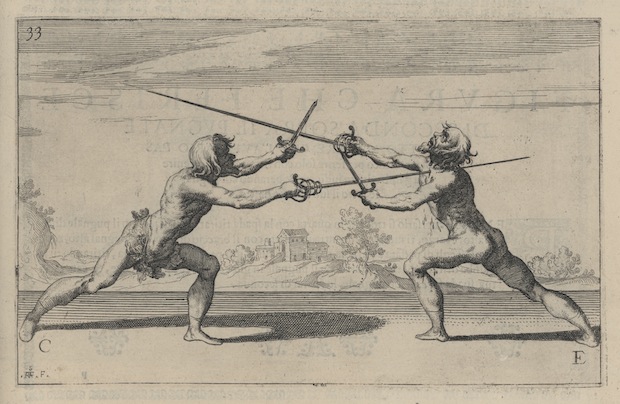
A counter attack is different from a parry and a riposte in that the defender seizes the moment/initiative away from the initial attacker as if they hadn’t even attacked versus defending and then attacking back. The German grandmaster Liechtenauer used the concept of Indes and the Italians used mezzo tempo or contra tempo to illustrate how to decisively and ‘instantly’ to feel out and orient their observations to take action and advantage of a moment in time during combat.
Counterattack: An offensive action executed into an opponent’s attack. A fencer might choose to counterattack if they believe their opponent’s attack will miss, or they might combine the counterattack with an evasive action (such as ducking beneath the opponent’s attack) or simultaneously using their blade to deflect their opponent’s attack during the counterattack (called a counterattack “in opposition”).
Parry and Riposte: uses the strength of one’s own blade to avoid the opponent’s blade. After performing it, the fencer then counters the attack with a combined attack which would force the opponent to parry, allow you to counter parry the opponent’s blade, and allow you to penetrate their next parry to win.
So for D&D purposes a great way to add this to the game is to allow proficient defenders to Counterattack weak attackers as an opportunity attack reaction.
This works great for any type of attack even a non-combat attack.
An NPC tries to use Intimidate on a character proficient with Insight and/or Intimidate. The intimidator fails badly so the defender could see the attack coming and before the NPC had even gotten the insult out the defender already had a comeback out and zinging.
Mechanics:
When a defender who is proficient in the skill, game, tool, or weapon is targeted by an attack or skill check in which the roll is a 1 or the total was less then the defender’s ‘To Hit’ total with their equipped and proficient weapon or appropriate skill total than they can react as if the attacker had provoked an attack of opportunity with their failed action.
Exempli Gratia:
The orc raises his battle axe over his head and telegraphs his attack with bunched muscles and a roar and rolls a 2 with a ‘To Hit’ bonus of +3 for a total of 5 missing by a mile. The skilled Knight seeing this responds with a thrust to the orc’s exposed throat before the axe even has a chance to come down.
The Knight had a ‘To Hit’ of +6 which is higher than the 5 rolled by the orc and thus the Knight has a chance to use her reaction to take a free shot at the orc with an opportunity attack.
Effects of House Rule:
This makes proficiency a much bigger deal which is very important at low levels and not very reflected by a +2 modifier. It adds a bit of spice to social combat as well providing a useful mechanic. When a low skilled character takes on a high skilled character by making a poor attack it really has a penalty now which should factor into a character’s cost benefit analysis and opportunity costs when dealing with a skilled or better enemy.
It also becomes interesting at high levels when a character is faced with a large number of incompetent enemies who leave themselves open every time they attack.
D&D House Rules:
Origin of the Abyss
Combat Overhaul
Shields
Character Creation Backgrounds
Crafting, Magic Items, and Economics
Familiarity, Proficiency, and Expertise
Character Focus
Tactics of Mistake
Counterattacking



